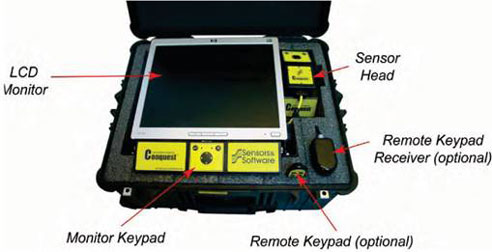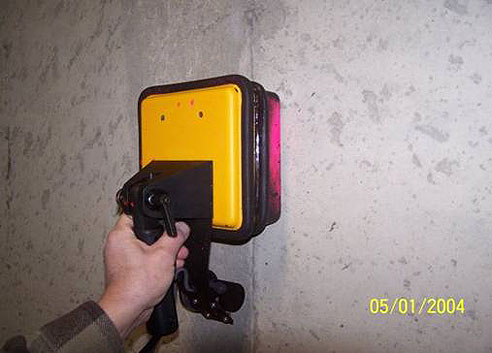Ground Penetrating Radar (GPR) systems by ScanMan Concrete scanning/x-ray or as its better known, Ground Penetrating Radar is a well established non-destructive method of investigating the internal composition of many naturally occurring materials such as rocks, earth and gravels as well as man made materials like brick, concrete and asphalt, etc. It can be used to detect metallic and non-metallic pipes, conduit, sewers, post tension cables, cables, cable ducts, voids, foundations, reinforcing in concrete and a whole host of other buried objects. It is also used to investigate the depth and make up of different strata layers. A common use has been to scan areas of land before excavation takes place. Principle of Operation The measured profile is termed a "time profile." The depth is expressed in terms of Two Way Travel Time (TWTT) rather than true depth. TWTT is the time taken for the signal to leave the antenna transmitter, bounce off the target and the reflected energy to return to the antenna receiver. The longer the time window over which the radar observes the reflected signal, the further the signal will have traveled. Our system has a time window that can be adjusted in steps from 6 nanoseconds (ns) to 800 ns. Generally the operator will be using the equipment in the range of 26 to 50 ns. A radar wave travels at different rates through different ground materials due to their differing EM Properties. Therefore, in order to be able to plot the profile as a true depth section, some method must be found which enables the speed of the propagation of the radar signal to be determined. If the ground simply consisted of a uniform media with isolated targets buried within it, the depth could be calibrated fairly accurately. The depth of penetration and the resolution of the measurements depend on a number of factors. Different types of ground behave very differently. Sand, loam, chalk, sand stone, Granite, etc. are all easy to penetrate and the radar can also be used to see through fresh water and snow. Cured concrete and other hard layers can be penetrated depending on the number and spacing of any reinforcing rods present. Soils which have a high percentage of dissolved salts and wet clay are the most difficult to work with. Surface Penetrating Radar  Above, the USRADAR 1GHz antenna to pinpoint structure in concrete.
|
0420 307 226 249 Towen Mountain Road, Towen Mountain, QLD, 4560
|



 Nationwide Ground Penetrating Radar
Nationwide Ground Penetrating Radar Structural Scanning & X-ray Services by
Structural Scanning & X-ray Services by Concrete Scanning Brisbane - X-Ray
Concrete Scanning Brisbane - X-Ray Surface Penetrating Radar Equipment
Surface Penetrating Radar Equipment Detecting Leaking Pipes Brisbane |
Detecting Leaking Pipes Brisbane | Underground Scanning Services Brisbane |
Underground Scanning Services Brisbane | Surface Penetrating Radar Brisbane |
Surface Penetrating Radar Brisbane | 3D Underground Scanning Services
3D Underground Scanning Services Bore Hole Safety Check | Scan Man
Bore Hole Safety Check | Scan Man Underground Cable Location | ScanMan
Underground Cable Location | ScanMan Concrete Scan/Xray Queensland from
Concrete Scan/Xray Queensland from Geophysical Surveys with Concrete
Geophysical Surveys with Concrete Underground Cable Locating Equipment
Underground Cable Locating Equipment Ground Penetrating Radar Brisbane from
Ground Penetrating Radar Brisbane from Concrete X-Ray Brisbane from ScanMan
Concrete X-Ray Brisbane from ScanMan 3D Imaging Services Sunshine Coast from
3D Imaging Services Sunshine Coast from Utility Locators Sunshine Coast from
Utility Locators Sunshine Coast from Underground Locators Gold Coast from
Underground Locators Gold Coast from GPR Services Gold Coast from ScanMan
GPR Services Gold Coast from ScanMan Concrete Testing Services Gold Coast
Concrete Testing Services Gold Coast
